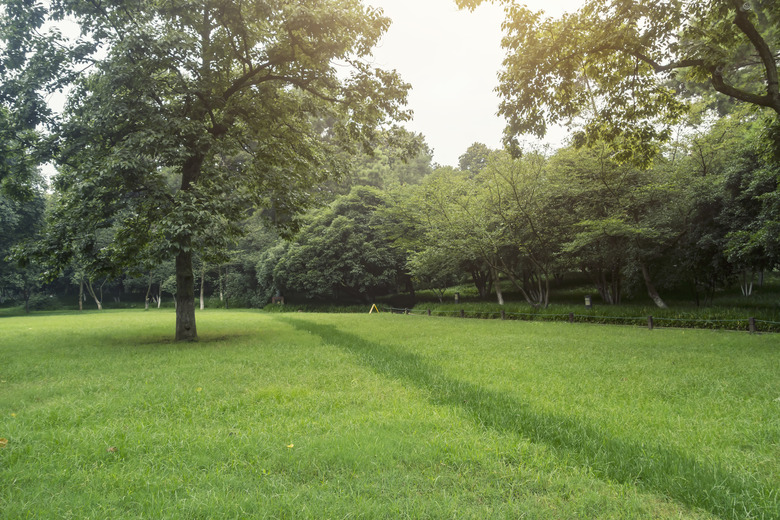Chemical Vs. Organic Lawn Care
We may receive a commission on purchases made from links.
A lush, verdant, weed-free lawn doesn't usually appear by happenstance. It's typically the result of an intentional chemical or organic lawn care regimen that includes much more than simply mowing the grass. When applied correctly, lawn fertilizers, weed control products and pesticides make a big difference toward promoting the health and maintaining the look of turfgrass.
When faced with a sea of DIY products that fill the shelves at local garden centers — or when choosing a lawn care company to handle turf maintenance — many homeowners are torn between the choice of using chemical fertilizers, herbicides and pesticides or organic equivalents. Each has its own merits, and there's not a one-size-fits-all recommendation for all lawns or all homeowners. Chemical versus organic lawn care ultimately depends on homeowner preference, but reviewing the pros and cons of each can help homeowners make an informed decision.
Natural, Organic, Inorganic and Chemical
Natural, Organic, Inorganic and Chemical
A cursory explanation of terms helps cut through the often-confusing designations that are batted about in the green industry and used to market products, leaving consumers scratching their heads as they try to figure out what the terms really mean.
- Natural. Natural products offer a clue to their origin because "natural" designates something that is found in nature. The implied benefit from a natural product is that it couldn't possibly be toxic or otherwise harmful;
after all, it's a naturally occurring substance. However, many plants produce
powerful defense mechanisms in the form of chemicals called phytochemicals
("phyto" = plant). These chemicals are natural, but they can also be deadly, so
any product simply labeled as "natural" doesn't carry an implied safety
benefit. - Organic. Likewise, all products labeled as "organic"
don't offer a guarantee of safety, whether they are safe for the environment or
safe for people and pets. Strictly speaking, an organic compound contains the
element carbon. Generally speaking, the term "organic" as it applies to products in the gardening world has a broader meaning beyond the requirement to contain the element carbon. It's now commonly recognized that an organic gardening product is one that's derived from a plant or animal source. - Inorganic. An inorganic gardening product is one that doesn't
contain the element carbon and isn't derived from a plant or animal source. It's the counterpart of an organic substance.
- Chemical. Although the word "chemical" may have
a negative connotation to devotees of organic gardening, this term applies to
organic and inorganic substances. In fact, water and oxygen are also chemicals, and no organic garden could exist without either of these chemicals.
To simplify the science and to use commonly accepted meanings in the gardening world, "chemical" commonly means an inorganic or synthetic chemical, and "organic" means a substance derived from plant or animal sources.
General Lawn Care Guidelines
General Lawn Care Guidelines
Regardless of whether you choose an organic or synthetic chemical approach to lawn care, there are some basic principles you can follow in order to boost the health of your turfgrass.
- One important guideline to follow is to avoid applying any type
of fertilizer randomly. It's impossible to look at a soil sample from your lawn
and determine the nutrient needs of the grass growing on it. By performing a
soil test every three years, you'll be able to assess the need for fertilizer
and the proper application rate to correct any nutrient deficiencies, but if
you toss out fertilizer on a routine basis, you may do more harm than good by
burning your turfgrass. - Although weed-and-feed products are marketed for the
consumer who is trying to streamline a lawn care and maintenance regimen by
making only one application instead of two, these products are not recommended.
The optimal times of year for fertilizing a lawn and using an herbicide to
control weeds do not fall in the same window. Know what type of turfgrass you
have and follow the recommended times of year for applying fertilizer and
herbicide. - Make sure your mower blades are sharp, mow when
the lawn is dry and cut no more than one-third of the total length of the leaf blades each time
you mow.
Chemical vs. Organic Lawn Fertilizers
Chemical vs. Organic Lawn Fertilizers
The turfgrass that makes up your lawn utilizes synthetic fertilizers the same as it utilizes organic fertilizers for nutrition. Plants absorb nutrients as ions regardless of whether the nutrients are supplied from chemical fertilizers or organic sources. So, no matter which category of lawn care fertilizer you use, as long as you apply it according to recommendations, you can grow a healthy lawn. It's important to note, however, that if you do not properly apply fertilizer, your lawn may be damaged even from an organic product.
Even though plants do not discern the difference between the nutrients they receive from synthetic chemical fertilizers or organic sources, using chemicals only serves a singular purpose, while using organic sources delivers a double benefit. Organic lawn fertilizers, such as alfalfa meal, cottonseed meal and feather meal, not only provide plant nutrition but they also provide a long-term benefit by improving the soil.
Over time, the way that organic fertilizers help build the soil is in large part by enriching the rhizosphere, which is the area around plant root zones where microbes break down organic matter. Because chemical fertilizers do not have this capability, they must be applied at higher concentrations, often at the expense of polluting streams and lakes because of their excessive runoff into storm drains.
Chemical fertilizers, while also providing plant nutrition, do not fortify the soil. Over time, improving the soil is a long-term benefit from organic fertilizers that synthetic chemicals fail to offer.
On the plus side for synthetic chemical lawn fertilizers, they supply nutrients to a lawn more quickly than organic products because the ions are "plant ready" after rainwater or irrigation water dissolves the fertilizer, which puts the ions in solution for plant roots to uptake. Organic fertilizers, on the other hand, aren't as quickly available to plants because they must first be broken down by soil microorganisms before the ions are ready to be absorbed by plant roots.
An additional benefit of a soil test is determining the soil pH, which optimally falls between 6.0 and 6.8 for turfgrass. If the soil pH is too far outside this window, plants cannot absorb the ions they need for healthy growth regardless of how much fertilizer you apply.
Chemical vs. Organic Lawn Herbicides
Chemical vs. Organic Lawn Herbicides
Managing weeds in a lawn considers three types of herbicides: pre-emergent or post-emergent, selective or nonselective and contact or systemic. A pre-emergent herbicide kills newly emerging weed seedlings, and it must be applied before the weeds are established, while a post-emergent herbicide kills mature weeds. Selective herbicides only kill certain types of weeds without killing your grass, while nonselective herbicides kill just about every type of plant material they contact, including weeds, turfgrasses, annuals and perennials. Contact herbicides damage plants wherever the chemical makes contact with a plant, and systemic herbicides move inside a plant to kill areas away from the place of application, which may be on the foliage or on the soil.
When choosing a weed killer, be sure to read the label to make sure you're buying the correct product for the type of turfgrass you have and the type of weed you're trying to eradicate (grassy or broadleaf). Always follow label recommendations for the time of year and the rate of application. You'll find different brand names that have the same active chemical ingredient. For example, atrazine, diquat, dicamba, triclopyr and 2,4-D are the common names for chemical ingredients that are found in numerous brand-name products.
Weed control arguably is the biggest challenge for the organic gardener. Even though it's difficult to eradicate all weeds in any lawn and keep them at bay, it's a little more difficult when exclusively using organic control methods. Perhaps the most realistic compromise for an organic gardener is to expect a certain amount of weeds among the turfgrass in a lawn instead of trying to annihilate every single weed that makes an appearance. Focusing instead on building a thick expanse of healthy grass is the best defense against weed establishment.
As a rule of thumb, organic herbicides are not as effective as synthetic chemical products. You'll also have to apply organic herbicides more often than their chemical counterparts. Some weeds form deep taproots, or they multiply by bulbs, rhizomes or tubers, which are all underground structures. These persistent weeds are difficult to kill using an organic herbicide, which may weaken or kill the above-ground part of a weed without killing its underground growth that keeps resprouting.
Some common active ingredients in organic and biorational herbicides include soaps, botanical oils (d-limonene, clove, cinnamon), acetic acid (vinegar weed killer) and HEDTA iron. Although corn gluten meal (CGM) is marginally effective as a pre-emergent herbicide, research has shown it doesn't live up to the hype surrounding its introduction in the 1990s. Environmental conditions and time of application have to be just right for CGM to inhibit weed seeds from germinating. It works by desiccation — keeping seed coats dry to prevent germination — so if there's too much rain or even periods of heavy dews or high humidity, CGM can't work.
Chemical vs. Organic Lawn Pesticides
Chemical vs. Organic Lawn Pesticides
Healthy lawns generally are able to withstand severe damage from insect pests. Plus, spraying every creepy-crawly creature you spy on your lawn can actually be counterproductive because many insects provide a benefit by controlling other insects that feed on plants. In fact, of the insect species in the United States, less than 1 percent are harmful to plants. Among the other 99 percent — the "good bugs" — are insects that eat the "bad bugs."
One common pest of turfgrass is the larval stage of numerous beetles, including Japanese beetles and June beetles, which live underground as grubs and feed on grass roots until they pupate and emerge from the ground as adult beetles. Because they're in the ground, you'll see the damage they cause before you see them. If a patch of grass quickly wilts, turns yellow and dies, it may be the result of grubs feeding on the roots. The affected area may also feel soft and spongy as you walk across it.
By peeling back a section of grass and inspecting the roots and the upper few inches of soil beneath it, you may find these larvae. Easy to spot, the grubs are white and C-shaped. A healthy lawn can handle five to seven grubs in a square-foot area, so the goal is not to try and eradicate all of them. If, however, grubs have done extensive damage in your lawn and they outnumber this amount, you can use a chemical or organic product to get them under control.
Chemical grub control is in the form of a preventative (applied before the grubs hatch in spring) or a curative (applied after the grubs have hatched in summer). You'll want to make sure that you choose the right product for the time of year you're targeting grubs. Two common active ingredients are imidacloprid and triclorfon. The downside of using these chemical controls is that you'll also be killing nontargeted bugs and insects, many of which are beneficial to the healthy soil environment underneath your lawn.
Using a product that contains the active ingredient chlorantraniliprole is not technically considered an organic control method but a "biorational" one. Biorational products are less toxic than conventional chemical controls, only minimally affecting pollinators and beneficial insects.
One long-term benefit of the judicious use of organic or biorational lawn care products versus more toxic chemicals is to maintain biodiversity by preserving animal species, even if it's only an insect species. Killing even one insect species in an environment can start a domino effect. The insects or animals that feed on the killed insect species are left without food; if they also perish, species higher on the food chain are also at risk.
The best practice for controlling grubs and other turfgrass pests is not to use any product — chemical, organic or biorational — unless your lawn suffers more than an acceptable threshold of aesthetic damage or if the overall health of your turfgrass becomes compromised.
References
- PennState Extension: Understanding Synthetic, Natural, Organic and Chemical Pesticide Designations
- Michigan State University Extension: What Organic Fertilizers Mean to Plants and Soil
- Texas A&M AgriLife Extension: Herbicides for Weed Control in Turfgrass
- University of Arizona Cooperative Extension: Corn Gluten Meal for Weed Control?
- University of Florida IFAS Extension: Beneficial Insects
- Clemson Cooperative Extension: White Grub Management in Turfgrass


